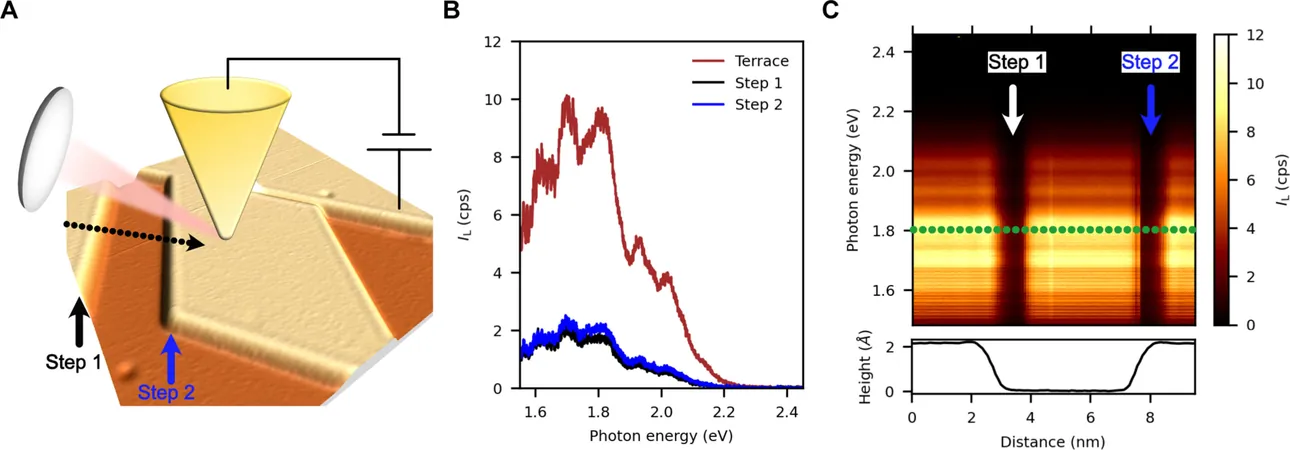
Unveiling the Atomic Secrets: How a Single Atom Can Revolutionize Light Directional Emission in Microscopes
2024-11-05
Author: John Tan
Introduction
In a groundbreaking study, researchers from Madrid have uncovered intricate mechanisms that enable the manipulation of light emission at the atomic scale, with potential implications for fields such as quantum computing. This innovative work provides a detailed analysis of how the behavior of light changes when a scanning tunneling microscope (STM) tip is positioned on an atomic step.
The Principles of Light Manipulation
At the heart of this research is the concept that light's properties in the far field are heavily influenced by events occurring in the near field. The STM technology allows scientists to manipulate light on a nanoscale level — below the wavelength of light itself. Utilizing a confined electromagnetic field established between the STM tip and the sample, typically only 1 nanometer apart, the researchers created a unique environment known as a nanocavity.
From Nanocavities to Picocavities
The introduction of atomic defects into this nanocavity transforms it into what is termed a picocavity, leading to extraordinary new properties. By strategically placing atomic steps within these cavities, the researchers were able to successfully control the direction of emitted light, a phenomenon previously noted but lacking a thorough scientific explanation—until now.
Research and Methodology
Led by prominent physicists Alberto Martín Jiménez and Roberto Otero at IMDEA Nanociencia, the team conducted experiments utilizing a picoantenna comprised of a gold STM tip and a smooth silver surface featuring an atomic step. Their findings, featured in the journal Science Advances, shed light on the complex interactions between electrons and light emission.
Observations and Discoveries
Their method involved the STM tip moving back and forth over the surface to collect data, revealing that varying amounts of light were emitted when electrons tunneled across atomic structures—particularly different between atomic steps and flat surfaces. By examining numerous atomic steps, the researchers discovered that the intensity of emitted light is dependent on the relative orientation of these steps to the direction of light collection, leading to a 'cardioid-type' directional profile rather than a uniform emission.
Clarifying the Mechanism
In collaboration with researchers from IFIMAC-UAM, they clarified the underlying mechanism of this light emission modification. The study showcased that in the confined spaces of STM, a mere atomic scale defect could drastically alter the electric field's distribution.
Implications and Future Prospects
Remarkably, the directional properties of emitted light are not the same across the atomic step, explaining why the profile is so sensitive to its orientation. This finding opens doors to the potential development of miniature antennas that can dictate light directionality at the nanoscale, offering exciting possibilities for new technologies.
Conclusion
The implications of this research are profound, suggesting a future where we can finely tune light emission from various sources like molecules and quantum dots. Understanding the optical features of atomic structures is pivotal not just for expanding scientific knowledge but also for the creation of innovative systems with practical applications in advanced fields such as quantum computing.
As we stand on the brink of a new frontier in nanotechnology and optics, this discovery could herald a transformation in how we harness and direct light at the atomic level, paving the way for breakthroughs that could redefine technological landscapes.



 Brasil (PT)
Brasil (PT)
 Canada (EN)
Canada (EN)
 Chile (ES)
Chile (ES)
 Česko (CS)
Česko (CS)
 대한민국 (KO)
대한민국 (KO)
 España (ES)
España (ES)
 France (FR)
France (FR)
 Hong Kong (EN)
Hong Kong (EN)
 Italia (IT)
Italia (IT)
 日本 (JA)
日本 (JA)
 Magyarország (HU)
Magyarország (HU)
 Norge (NO)
Norge (NO)
 Polska (PL)
Polska (PL)
 Schweiz (DE)
Schweiz (DE)
 Singapore (EN)
Singapore (EN)
 Sverige (SV)
Sverige (SV)
 Suomi (FI)
Suomi (FI)
 Türkiye (TR)
Türkiye (TR)
 الإمارات العربية المتحدة (AR)
الإمارات العربية المتحدة (AR)